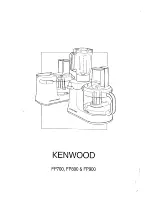
4
to use your liquidiser
1 Fit the sealing ring
into the blade unit
- ensuring the seal is located correctly.
Leaking will occur if the seal is
damaged or not fitted correctly.
2 Screw the jug onto the blade unit.
3 Put your ingredients into the jug.
4 Push the lid seal onto the underside of the
lid.
5 Fit and lock the filler cap in the lid, by
turning one position
.
6 Fit the lid to the goblet and turn
the filler cap to
to lock.
The filler cap can be located in 3 different
positions (see
A
)
- filler cap removable for adding
ingredients to the jug.
- lid unlocked/filler cap locked to the
lid for fitting and removing the lid.
- lid locked.
7 Place the liquidiser onto the power unit and
turn to lock
.
8 Select a speed or use the pulse control.
hints
●
When making mayonnaise, put all the ingredients, except the oil
into the liquidiser. Then with the machine running, pour the oil into
the filler cap and let it run through.
●
Thick mixtures, eg pates and dips, may need scraping down. If
it’s difficult to process, add more liquid.
●
When crushing ice use the pulse in short bursts
important
●
Allow all liquids to cool to room temperature before
placing them in the liquidiser.
●
To ensure the long life of your liquidiser, never run it for longer
than 60 seconds. Switch off as soon as you’ve got the right
consistency.
●
Don’t process spices - they may damage the plastic.
●
The machine won’t work if the liquidiser is fitted incorrectly.
●
Don’t put dry ingredients into the liquidiser before switching on. If
necessary, cut them into pieces; remove the filler cap; then with
the machine running, drop them through one by one.
●
Don’t use the liquidiser as a storage container. Keep it empty
before and after use.
●
Never blend more than 1
1
⁄
2
litres (2pts 12floz) - less for frothy
liquids like milkshakes.
Note: The mini chopper/mill base is not
interchangeable with the glass liquidiser jug. The
processor will not operate if the wrong base is fitted.
Refer to graphics on blade unit bases.
using the attachments
see chart for speed of each attachment.
knife blade/
dough tool
The knife blade is the most versatile of all
the attachments. The length of the
processing time will determine the texture
achieved. For coarser textures use the
pulse control.
Use the knife blade for cake and pastry
making, chopping raw and cooked meat,
vegetables, nuts, pate, dips, pureeing
soups and to also make crumbs from
biscuits and bread. It can also be used
for yeasted dough mixes if the dough
tool is not supplied.
Use the dough tool for yeasted mixes.
hints
knife blade
●
Cut food such as meat, bread,
vegetables into cubes approximately
2cm/
3
⁄
4
in before processing.
●
Biscuits should be broken into pieces and added down the feed
tube whilst the machine is running.
●
When making pastry use fat straight from the fridge cut into
2cm/
3
⁄
4
in.cubes.
●
Take care not to over-process.
dough tool
●
Place the dry ingredients in the bowl and add the liquid down the
feed tube whilst the machine is running. Process until a smooth
elastic ball of dough is formed this will take 60 - 90 secs.
●
Re-knead by hand only. Re-kneading in the bowl is not
recommended as it may cause the processor to become
unstable.
twin beater geared whisk
Use for light mixtures only eg egg whites, cream, evaporated
milk and for whisking eggs and sugar for fatless sponges.
Heavier mixtures such as fat and flour will damage it.
using the whisk
1 Fit the drive shaft and bowl onto the
power unit.
2 Push each beater securely into the drive
head
.
3 Fit the whisk by carefully turning until it
drops over the drive shaft.
4 Add the ingredients.
5 Fit the lid - ensuring the end of the shaft
locates into the centre of the lid.
6 Switch on.
important
●
The whisk is not suitable for making one-
stage cakes or creaming fat and sugar as these mixes will
damage it. Always use the knife blade for cake making.
hints
●
Best results are obtained when the eggs are at room
temperature.
●
Ensure the bowl and whisks are clean and free from grease
before whisking.
A
0.3
0.5
0.7
1.1
1.3
1.5
0.9
0
min
max
multi pro
P
0.3
0.5
0.7
1.1
1.3
1.5
0.9
Summary of Contents for multipro FP921
Page 1: ...FP921 ...







































